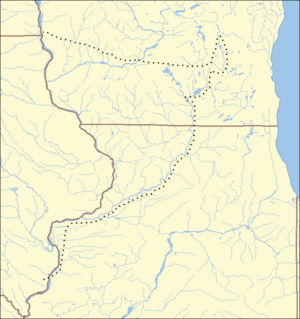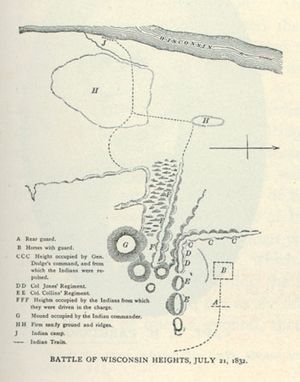Battle of Wisconsin Heights facts for kids
Quick facts for kids Battle of Wisconsin Heights |
|||||||
|---|---|---|---|---|---|---|---|
| Part of the Black Hawk War | |||||||
 An early depiction of the battlefield near present-day Sauk City, Wisconsin |
|||||||
|
|||||||
| Belligerents | |||||||
Menominee |
Sauk/Fox | ||||||
| Commanders and leaders | |||||||
| Henry Dodge James D. Henry |
Black Hawk | ||||||
| Strength | |||||||
| 600–750 militia | approximately 50–80 warriors | ||||||
| Casualties and losses | |||||||
| 1 killed 8 wounded |
40–70 killed | ||||||
The Battle of Wisconsin Heights was a major fight during the Black Hawk War in 1832. It happened between the United States militia (citizen soldiers) and their allies, and the Sauk and Fox tribes. The Sauk and Fox were led by a brave chief named Black Hawk.
This battle took place in what is now Dane County, near Sauk City, Wisconsin. Even though Black Hawk's warriors were greatly outnumbered and many were killed, they fought hard. This allowed most of the Sauk and Fox families to escape across the Wisconsin River. Sadly, this escape was only for a short time. When the militia caught up with them later, it led to a very difficult event known as the Bad Axe massacre.
Contents
Why Did the Battle of Wisconsin Heights Happen?
The Treaty and Black Hawk's Return
In 1804, a treaty was made between the Governor of Indiana Territory and some Sauk and Fox leaders. This treaty was about giving up land in Illinois. Because of this, the Sauk and Fox tribes moved west of the Mississippi River in 1828.
However, Black Hawk and others did not agree with this treaty. They said that the whole tribe was not asked, and the leaders who signed it did not have the right to give away their lands. Black Hawk was upset about losing his homeland. From 1830 to 1831, he led his group back across the Mississippi River several times. Each time, he was convinced to go back without any fighting.
In April 1832, Black Hawk hoped other tribes and the British would help him. He led his group, called the "British Band," back into Illinois. This group included about 1,000 warriors and their families. But he found no allies. He then tried to return to Iowa, but things quickly got out of hand. This led to the Battle of Stillman's Run, which was the first fight of the war. After that, more battles followed, and the militias from Michigan Territory and Illinois began to hunt for Black Hawk's band.
The Chase Through Wisconsin
After a small fight in late June at Kellogg's Grove, Black Hawk and his band ran from the approaching militia. They traveled through what are now Beloit and Janesville. Then they followed the Rock River toward Horicon Marsh. From there, they went west toward the Four Lakes area, which is near modern-day Madison. The band camped for the night near Pheasant Branch.
How Did the Battle Begin?
Following Black Hawk's Trail
The U.S. force had about 600 to 750 militia men. They found Black Hawk's trail after the Battle of Pecatonica. Colonel Henry Dodge and James D. Henry chased the band up the Rock River. They had small fights along the way.
The day of the battle, the militia marched about 25 miles (40 km) from Four Lakes. They found the body of a dead Native American. In his pouch, they found a watch belonging to George Force, a lieutenant killed in an attack at Fort Blue Mounds on June 20.
Scouts and the River
Before the main militia group, some U.S. allied Ho-Chunk warriors were sent ahead to scout. They were with Pierre Pauquette, a trader. There were rumors that Black Hawk's band was at Lake Koshkonong. Dodge and his men tried to find Black Hawk there. Black Hawk's band had already left the lake, but the militia found signs they had been there. They picked up the trail again and continued chasing them toward the Wisconsin River.
| Map of Black Hawk War sites Symbols are wikilinked to article |
Black Hawk's group was in poor health. They could not stay in one place long enough to get food. Some of them died from hunger. Black Hawk later said that at this point, he only wanted to escape with his people back across the Mississippi River. But when he met the large U.S. force at Wisconsin Heights, he felt he had to fight. His goal was to let the women, children, and elders in his group escape across the Wisconsin River.
What Happened During the Battle?
The Fight Begins
On July 21, 1832, the militia caught up with Black Hawk's band. They were trying to cross the Wisconsin River. This was near what is now Roxbury, in Dane County, close to Sauk City, Wisconsin.
As the militia got closer, warriors appeared on the hills around them. They were trying to get the militia's attention. Before the main fight, three U.S. scouts met a small group of Sauk or Fox warriors. The scouts chased them close to their camp. The scouts also killed two Sauk warriors before the main battle started.
Black Hawk's Stand
The scouts who had chased the three Sauk warriors returned. Warriors from Black Hawk's camp then chased the scouts on horseback. Colonel Dodge had his troops get off their horses and told them to move to higher ground. Black Hawk's warriors moved toward the militia. When they were about 30 yards (27 meters) away, the militia and their allies started shooting.
Black Hawk told his men to "stand their ground, and never yield it to the enemy." Black Hawk's strong will saved many lives that day. The warriors fought bravely with the militia. This gave most of the Sauk and Fox families time to escape on rafts across the Wisconsin River.
In the first shots of the battle, one of Black Hawk's warriors was killed right away. One or two others were wounded. Black Hawk's warriors shot back as they pulled away. They went straight into the charging militia.
Militia Ridge and the End of the Battle
Dodge and a Major Ewing reached the battlefield at Wisconsin Heights first. They captured a high area that later became known as "Militia Ridge." The militia had a strong position when General Henry arrived. He brought three groups of mounted Illinois Militia. Henry set up his men in a firing line. They exchanged gunfire with Black Hawk's men for about 30 minutes.
A charge led by Dodge, using bayonets (knives attached to rifles), ended the battle. The remaining warriors scattered. The militia chased them, and several more warriors were killed. The troops did not chase Black Hawk right away. Dodge said, "after consulting with Genl. Henry it was agreed to defer a further attack on the enemy until the next morning."
Dodge counted 40 Sauk dead, possibly more. He had seen wounded Sauk being carried away during the fight. Dodge's forces had one person killed and 8 wounded. One of the wounded was hurt before the battle, during the march to Wisconsin Heights.
What Happened After the Battle?
The Disappearance and the Message
The U.S. militia decided to wait until the next day to chase Black Hawk. To their surprise, when morning came, their enemy was gone. Just before dawn, one of Black Hawk's leaders, a Sauk chief named Neapope, tried to talk to the militia officers. He was on the hill where his group had taken shelter. He wanted to explain that his group only wanted to stop fighting and go back across the Mississippi River.
He spoke in a "loud shrill voice" in his native Ho-Chunk language. He thought Pauquette and his Ho-Chunk guides were still with the militia. But the U.S. troops did not understand him. Their Ho-Chunk allies had already left the battlefield.
Casualties and Legacy
The one militia man killed in battle, Thomas Jefferson Short, was buried somewhere at the battle site. The battle was very hard for Black Hawk and his band. Even though many escaped across the Wisconsin River, it's thought that up to 70 Sauk and Fox people died. This includes those killed in the fighting and those who drowned. Even so, some people consider this battle, along with Stillman's Run, one of Black Hawk's biggest military successes.
The militia gathered again at Blue Mounds Fort. They found Black Hawk's trail again on July 28 near Spring Green, Wisconsin. When they finally caught up with Black Hawk's "British Band" again, it led to the final big fight of the war at Bad Axe. At the mouth of the Bad Axe River, many men, women, and children were killed by soldiers, their Native American allies, and a U.S. gunboat.
Preserving the Battlefield
The place where the Battle of Wisconsin Heights happened is now preserved. It is in northwestern Dane County, about two miles (3 km) southeast of present-day Sauk City on State Highway 78. The Department of Natural Resources owns it, and it is open to the public. It is the only battle site from the American Indian Wars in the U.S. Midwest that is still mostly as it was. The Wisconsin Heights Battlefield was added to the U.S. National Register of Historic Places on January 31, 2002.
The exact location of the battle is confirmed in the notes of U.S. Deputy Surveyor John H. Mullet. He surveyed the area on October 23, 1832, just three months after the battle. This record provides clear proof of where the battle took place.
Images for kids








